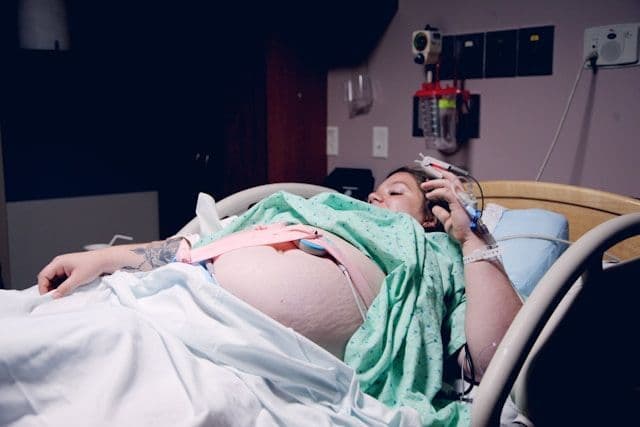Is This True Labor or Braxton Hicks Contractions?
Labor & Delivery
Obie Editorial Team

Understanding Braxton Hicks Contractions
Think of Braxton Hicks contractions as your body's way of gearing up for the big day. Your uterus starts practicing so it's ready when it's time to welcome your baby. Differentiating these practice contractions from true labor can sometimes be tricky, whether you're a first-time mom or an experienced one.
Named after Dr. John Braxton Hicks, a British doctor who first described these pre-labor contractions, Braxton Hicks contractions can often lead new moms to head to the hospital, only to find out it's not yet time. While these can be uncomfortable and confusing, they're a normal part of the pregnancy process.
Note: If you experience regular contractions before 37 weeks (more than 3 weeks before your due date), this could indicate premature labor, which isn't normal. Contact your doctor immediately if this happens.
Your pregnancy hormones are to thank for these early practice contractions. These hormones help prepare your uterus for the main event, gradually teaching it how to contract effectively.
True Labor Contractions
When it's time for your baby to meet the world, your body undergoes several changes. The brain sends signals to release oxytocin and prostaglandins, hormones that start the labor process. Initially, these contractions might feel similar to Braxton Hicks or even gas pains, but they soon become more regular and intense.
Labor contractions fall into three categories:
- False labor contractions: False labor contractions mimic active labor contractions but don't cause cervical dilation and effacement.
- Practice (Braxton Hicks) contractions: Braxton Hicks contractions are common from week 32 until birth.
- Active labor contractions: Active labor contractions occur during birthing and help thin and open the cervix.
Recognizing True Labor Contractions
Here are six signs that active labor has begun and that you should start monitoring your contractions:
- Movement intensifies the contractions.
- Pain increases in strength and frequency.
- Accompanied by nausea or intestinal discomfort.
- Pain radiates to the lower back, upper abdomen, and thighs.
- The mucus plug passes or you notice bloody spots.
- Your water breaks.
If you experience any of these signs with your contractions, it's time to call your doctor or midwife.
Pain Relief During Labor
Every mother's experience with labor is unique, and pain management is a personal choice. For those opting for a natural birth, techniques like walking, changing positions, and breathing exercises can offer relief. For others, medical pain relief options will be available at the hospital to help keep you comfortable.
What Braxton Hicks Contractions Feel Like
Braxton Hicks contractions are usually described as a tightening sensation in the abdomen that comes and goes. They don't become more frequent, get stronger over time, or last longer like true labor contractions. Typically, they don't occur more than once or twice per hour. If you're under 37 weeks and have more than three to four contractions per hour, contact your doctor immediately as this could be a sign of premature labor.
What True Labor Contractions Feel Like
The sensation of contractions varies for each woman and can even differ between pregnancies. True labor contractions may be felt as a dull ache in the back and lower abdomen, accompanied by pelvic pressure. Some describe them as strong menstrual cramps or similar to diarrhea cramps.
False labor often feels much like active labor, which is especially confusing for new mothers. Most often, it includes strong Braxton Hicks contractions, acting like exercises for your uterus without causing cervical changes.
Here are some additional signs to differentiate false labor from active labor:
Progression: Active labor contractions increase in intensity and frequency, with intervals starting around 20 to 30 minutes apart, gradually decreasing until they occur every two minutes.
Walk It Off: Braxton Hicks contractions typically ease with movement or rest, unlike true labor contractions.
Location: True labor contractions usually start in the lower back and move to the front of the abdomen, whereas false labor contractions are felt more in the front and pelvic area.
If you're unsure, always consult your doctor or midwife about any pains or contractions. Getting your questions answered can help prevent unnecessary trips to the hospital.
How to Identify True Labor Contractions
Ask yourself these questions to determine if your contractions indicate true labor:
| Contraction Characteristics | False Labor | True Labor |
| How often do the contractions occur? | Contractions are often irregular and do not get closer together | Contractions come at regular intervals and last about 30-70 seconds. As time goes on, they get closer together. |
| Do they change with movement? | Contractions may stop when you walk or rest, or may even stop if you change positions | Contractions continue despite movement or changing positions |
| How strong are they? | Contractions are usually weak and do not get much stronger. Or they may be strong at first and then get weaker. | Contractions steadily increase in strength |
| Where do you feel the pain? | Contractions are usually only felt in the front of the abdomen or pelvic region | Contractions usually start in the lower back and move to the front of the abdomen |
If you think you're experiencing true labor, contact your healthcare provider immediately. Look for these signs:
- Contractions (muscle tightening in the uterus causing discomfort or a dull ache in the lower abdomen) occurring every 10 minutes or more frequently within an hour
- Regular tightening or pain in your back or lower abdomen
- Pressure in the pelvis or vagina
- Menstrual-like cramps
- Bleeding
- Fluid leakage
- Flu-like symptoms such as nausea, vomiting, or diarrhea
For Braxton Hicks contractions, you don't usually need to take any action unless they're uncomfortable. Try these methods for relief:
- Take a walk. False labor contractions often stop when you change position or get up and walk
- Get some sleep or rest
- Relax
- Drink water, juice, or herbal tea
- Eat a snack or small meal
- Get a massage
| Braxton Hicks Contractions | True Labor |
| Irregular in intensity Infrequent Unpredictable No cervical changes Uncomfortable | Strong Regular Less than 2-3 minutes apart Last longer than 30 seconds Cervix changes Painful |
Can Braxton Hicks Contractions Affect the Baby?
If these contractions are indeed Braxton Hicks and not premature labor, they're unlikely to affect your baby. They don't increase the risk of preterm birth. In fact, some doctors believe these contractions tone your uterus and promote blood flow to the placenta, nourishing your baby.
Managing Braxton Hicks Contractions
Braxton Hicks contractions are usually more of an annoyance than painful. If they're not true labor contractions, no treatment is necessary. However, if you're before 37 weeks and experiencing four or more contractions in an hour, contact your doctor as this might indicate preterm labor.
Can You Prevent Braxton Hicks Contractions?
Preventing Braxton Hicks contractions is not possible. Staying well-hydrated and avoiding excessive physical activity can help minimize them. Always be vigilant for signs of preterm labor.
When to Call Your Doctor:
- Bright red vaginal bleeding
- Continuous fluid leakage or if your water breaks (felt as a gush of fluid)
- Strong contractions every 5 minutes for an hour
- Contractions that you cannot "walk through"
- A noticeable change in your baby’s movements or less than 10 movements in two hours
- Any signs of contractions if you are not yet 37 weeks
Read More













